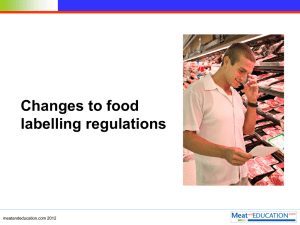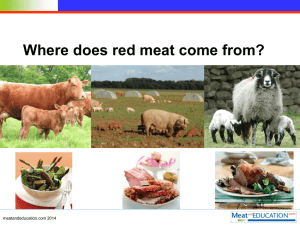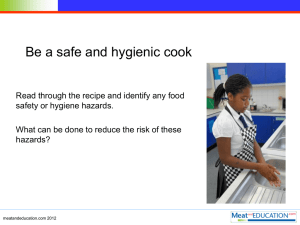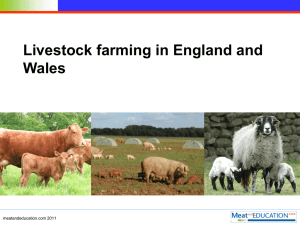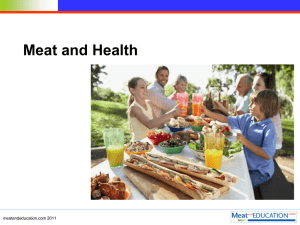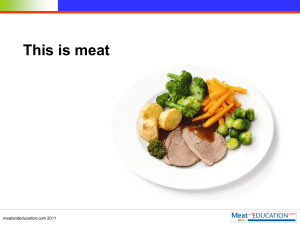6.93 MB - Meat and Education
advertisement
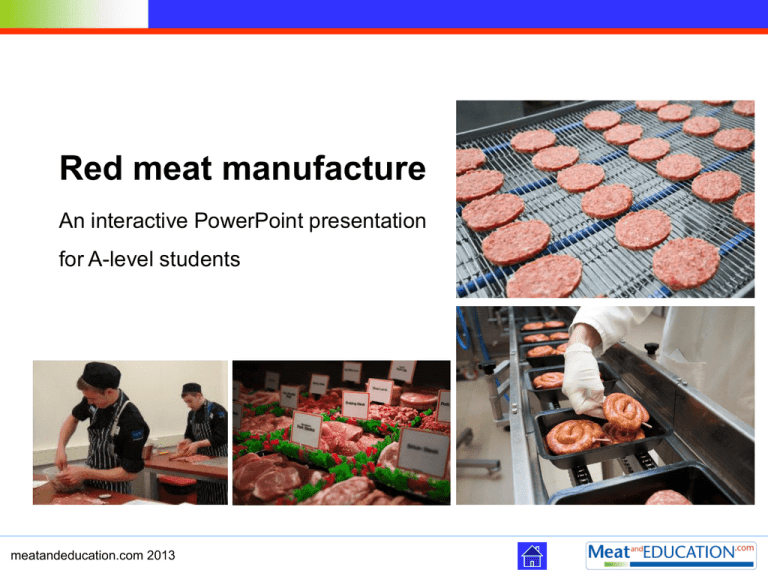
Red meat manufacture An interactive PowerPoint presentation for A-level students meatandeducation.com 2013 Welcome Use the following buttons to guide you through this resource. This button takes you to the main menu. This button moves you to the next slide. This button moves you to the previous slide. meatandeducation.com 2013 Menu Click on the information section you wish to read. Click Questions, if you are ready to take the multiple choice quizzes. Information 1. Primary processing - Mince Questions 2. Secondary processing - Sausages Questions 3. Secondary processing - Beef burgers Questions Extension Questions meatandeducation.com 2013 End Background information - primary processing Red meat is edible raw, yet it is normally processed and cooked prior to consumption. Primary processing is the first step which involves preparing raw ingredients. The first stage is to drain the blood from the carcase. Red meat can be stored at above its freezing point (–1.5 °C) between two three weeks without spoilage. meatandeducation.com 2013 Background information - primary processing When an animal is killed, the circulation of blood ceases, but within the muscles glucose continues to be broken down (in the production of ATP (Adenosine triphosphate) under anaerobic glycolysis. This is due to a lack of oxygen and results in the production of lactic acid. Lactic acid reduces the pH of the muscle and inhibits the growth of microorganisms, thereby slowing food spoilage and increasing the shelf-life of the meat. The chemical reactions within the muscles gradually slow down. As a result actin and myosin combine and the muscle contracts, but is no longer able to relax leading to rigor mortis, the point at which the muscles become firm and inextensible. meatandeducation.com 2013 Background information - primary processing Red meat must also be hung or ‘aged’ to allow the muscle fibres to relax, otherwise it will not be tender. Proteolytic enzymes (these breakdown the protein chains into smaller peptides and amino acids) help to tenderise the meat while it is aged. As the carcases are hygienically prepared, the following storage life can be expected: • Beef and veal up to 21 days • Lamb up to 15 days • Pigs up to 14 days • Offal up to 7 days meatandeducation.com 2013 What does primary processing include? Once hung, the carcase is divided into fore and hindquarters. A butcher will begin to trim the carcase into joints and cuts in line with modern demand from consumers. Every carcase consists of consumable and non-consumable parts, e.g. bone, lean meat, fat and waste. Approximately 35% of any carcase can be butchered and sold. Some primary processes undertaken by the butchers include: • boning • slicing • mincing. A variety of by-products can be produced from the remaining carcase, e.g. pet food manufacture, edible fats, gelatine and collagen production and sheep and cow hide processing. meatandeducation.com 2013 Beef – examples of cuts produced by a butcher Stir-fry strips Rib-eye Steaks Topside Steaks Chuck Steak Forerib Fillet Steaks Shank Topside Joint Shank Diced Chuck Shin Rings meatandeducation.com 2013 Rolled Brisket Sirloin Steaks Rump Steaks Silverside Joint Lamb – examples of cuts produced by a butcher Valentine Steaks Racks Loin Chops Boneless Leg Steaks Diced Boneless Rump Cutlets Noisettes Shank Neck Fillets Kebabs Rolled Shoulder meatandeducation.com 2013 Rump Steak Half Leg Shoulder steak Mince Stir-fry Strips Pork – examples of cuts produced by a butcher Rack Roast Rolled Shoulder Joint Valentine steaks Rolled Shoulder Joint Rump steaks T-Bone Chops Rib chops Tender Loin Osso Busso Belly strips Spare ribs Leg steaks Boneless Leg Hock Diced meatandeducation.com 2013 Stir-fry Strips Mince Mince is 100% meat (typically containing 1025% fat) with no added water, additives, fillers or any other ingredients. Different grades of mince can be produced by the butcher. Standard mince contains on average 20% fat. Any mince identified as lean will contain no more than 10%. Organic minced meat is available for a premium price. The animals used for this type of mince will have been reared according to organic standards. Mince provides consumers with a versatile ingredient base for many dishes, e.g. koftas, meatballs or curries. meatandeducation.com 2013 Mincing The process of mincing involves: • trimming the meat to be minced • placing the raw pieces of meat into the hopper of a mincing machine • the feeding ‘worm’ rotates, drawing the meat along a cylindrical barrel • star shaped blades rotate within the worm forcing the meat through holes in perforated plates or grinding disks • heat may be applied or removed, depending on the product • the mince is extruded through the perforated plate into a meat tray. meatandeducation.com 2013 Click to view the Digi Bite Mincing When mincing frozen meat or meat with a lot of connective tissue, plates with larger perforations are used to produce a coarse mince. The mixture is then drawn through plates with smaller perforations for a finer texture. A variety of plates can be used on one machine – the size of the final perforations will determine the final size of the piece of minced meat. Hopper Heating elements (optional) Blade Drive unit and gear box Feeding worm meatandeducation.com 2013 Plate The colour of red meat When meat is cut it loses water from the cut surface and becomes darker in colour. The protein myoglobin is purple in colour because it contains iron and haem. When meat is cut and exposed to air, the myoglobin is converted to oxymyoglobin, which is bright red. Consumers associate the red colour in meat with freshness. It is important for food manufacturers to maintain a red colour within the meat which means keeping myoglobin in the oxymyoglobin form to meet consumer expectations. If the supply of oxygen is inadequate, the pigment is oxidised to metmyoglobin, which is brown. meatandeducation.com 2013 The colour of red meat H20 Fe3+ Globin protein Haem Metmyglobin (Brownish red) Oxymyglobin (bright red) 02 Fe2+ Myoglobin (purple red) - oxygen Globin protein Haem + heat Denatured globin Haemochrome (brown to grey) meatandeducation.com 2013 + oxygen H20 Fe2+ Globin protein Haem When meat is packaged it gradually uses up the oxygen present and at low levels of oxygen the pigment turns brown through oxidation. Using high oxygen packs enables the high levels of oxygen to be maintained longer in meat, keeping the red appearance for longer. Question 1 Why is red meat hung or aged? 1. To allow proteolysis to tenderise the meat. 2. To allow the micro-organisms to grow. 3. To allow the meat fibres to contract. 4. To prevent a build up of lactic acid. meatandeducation.com 2013 Question 1 Correct, well done. Click the arrow to go to the next question. meatandeducation.com 2013 Question 1 Incorrect, try again. Click this arrow to go to try the question again. Click this arrow to go to try the next question. meatandeducation.com 2013 Question 2 True or false? The enzymes within the meat continue to metabolise glucose anaerobically producing lactic acid, which in turn slows down the growth of microorganisms. 1. True 2. False meatandeducation.com 2013 Question 2 Correct, well done. Click the arrow to go to the next question. meatandeducation.com 2013 Question 2 Incorrect, try again. Click this arrow to go to try the question again. Click this arrow to go to try the next question. meatandeducation.com 2013 Question 3 Which protein provides the preferred meat colour associated with freshness by consumers? 1. Metmyoglobin 2. Myoglobin 3. Oxymyoglobin 4. Haemochrome meatandeducation.com 2013 Question 3 Correct, well done. Click the arrow to return to the next question. meatandeducation.com 2013 Question 3 Incorrect, try again. Click this arrow to go to try the question again. Click this arrow to return to the main menu. meatandeducation.com 2013 Question 4 Which of the following is not an example of primary processing? 1. Sterilisation 2. Mincing 3. Slicing 4. Boning meatandeducation.com 2013 Question 4 Correct, well done. Click the arrow to return to the main menu. meatandeducation.com 2013 Question 4 Incorrect, try again. Click this arrow to go to try the question again. Click this arrow to return to the main menu. meatandeducation.com 2013 Background information – secondary processing Secondary processing is the conversion of meat cuts from primary processing to food products. This could include a large number of products, such as: • sausages • cold meats • cured meats • pies and pasties • burgers • pâtés • ready or frozen meals. Throughout the manufacture of each food product, safety and hygiene remain vitally important. meatandeducation.com 2013 Hazard and Critical Control Points HACCP (Hazard Analysis and Critical Control Point) is a pro-active system, where all potential hazards to food product safety at each stage of the production chain are identified. A Critical Control Point (CCP) is a point, step or procedure where control must be applied to prevent, eliminate or reduce a food hazard to an acceptable level. To assure food safety, each CCP is monitored to check that it is within critical limits. If limits are in danger of being broken, corrective action must be taken. This systematic approach, if properly implemented, should ensure the safe production of food. meatandeducation.com 2013 7 principles of a HACCP system These principles include: 1. Conduct a hazard analysis and develop production flow charts. 2. Identify the CCP’s. 3. Establish critical limits i.e. set target levels which must be met to ensure the CCP is under control. 4. Establish a system to monitor control of the CCP. 5. Establish corrective actions to be taken when monitoring indicates that a CCP is not under control. 6. Establish procedures for verification to confirm that the HACCP system is working correctly. 7. Establish documentation/records for all procedures. meatandeducation.com 2013 Sausage manufacture Sausage manufacture involves combining a variety of ingredients, in the right proportions, to produce the desired quality of sausage. Cost is also a key consideration. In the United Kingdom (UK) fresh sausages are made from fresh meat which are neither cured, smoked, fermented or cooked. Fresh sausages must be kept under refrigeration prior to cooking and consumption. meatandeducation.com 2013 Raw material procurement and intake Sausage manufacturers carefully identify ingredient providers (who are audited ) and careful records are kept for each delivery. Ingredients are thoroughly inspected before they are received and stored at the factory. This ensures full traceability. The basic ingredients to produce sausages include: • pork • rusk • seasoning • casings. Some sausages will also include additional ingredients such as fruit or vegetables and cheese. meatandeducation.com 2013 Raw material storage and preparation Temperature control is vital in order to limit the growth of microorganisms. Correct storage, in terms of temperature and location of the ingredients and separation of potential allergens, is a key Critical Control Point (CCP). Refrigeration Perishable ingredients are stored in a refrigerated room. The refrigerator temperature is held between 1-4°C. Ambient temperature Other non-perishable ingredients and packaging materials are stored at ambient temperature (20-25°C) in a separate area. Production environment The factory working environment is set at 10°C in order to reduce the growth of microorganisms in the product during production. meatandeducation.com 2013 Allergens Certain ingredients which can cause an allergic reaction, such as gluten, are stored in a separate location (refrigerated or in ambient temperature) in order to reduce the risk of contamination. Mincing the pork meat Before The pork meat will be inspected and weighed. An accurate amount of pork is placed inside a hopper of the large mincer. A certain amount of pork fat is also added and is essential to help improve the flavour and succulence of the sausages. After Rotating blades will cut the meat into fine pieces. The size reduction of the meat and fat takes place as the sharpened blades rotate at about 100 revolutions per minute (rpm). Blade Hopper Rotating blades Feeding worm Drive box and gear unit Plate meatandeducation.com 2013 Additional ingredients Once the pork has been minced, other ingredients are added, such as rusk, seasoning and water. Different varieties of rusk, such as fine or coarse, may be used to change the texture of the sausage filling. Rusk absorbs moisture from the meat and water. It is known to have a high water absorbency capacity of about 3-4 times its weight and helps to bind the mixture together. The required amount of rusk, seasoning and water are measured and added to the hopper. meatandeducation.com 2013 Additional ingredients The accurate addition of ingredients is a Critical Control Point (CCP) in the sausage making process. It is vital the correct amount of ingredients are added to ensure a consistent product each cycle. The sausage filling is mixed with the rotating blades and then drawn along a feeding worm. The feeding worm rotates and draws the filling along a cylindrical barrel towards star shaped blades which rotate. The worm presses the meat through holes in perforated plates or grinding disks. The sausage filling is returned to the cold store to reduce the temperature of the mixture, which has risen due to the mechanical action of the mincer. meatandeducation.com 2013 Click to view the Digi Bite Filling the sausages It is important that sausages are identical in length, diameter and weight, to create a uniform product each cycle. This ensures that the weight and nutrition content of the sausages matches the information displayed on the packaging. When the temperature of the sausage filling has reduced, it is either manually or automatically transferred into the hopper of the vacuum filler or sausage filling machine. This machine will determine how many grams of mixture will be extruded into each sausage casing. The set amount of filling for the recipe is programmed into the machine. meatandeducation.com 2013 Filling the sausages The feeding worm attached to the hopper draws a specific amount of the filling under vacuum conditions into the nozzle to be extruded into casings. The casings will automatically or manually be placed onto the linking nozzle. A specific amount of sausage filling will be extruded into a section of the casing. The machine ensures optimum portioning accuracy, precise distribution of the filling and produces compact, firm sausages. Hopper Linking nozzle Chilled sausage filling Filling table meatandeducation.com 2013 Feeding worm Computer controls Filling the sausages A length portioning device, attached at the end of the nozzle, accurately portions a consistent weight of sausage filling and therefore creates a consistent length of sausage. Linking nozzle The sausage mixture passes through the calibrating horn of the length portioning device into the casing and onto the filling table. Length portioning device meatandeducation.com 2013 Casings Casings, known as sausage skins, play a significant role in the portioning of sausage meat. Casings also improve the shelf life by providing moisture and oxygen resistant properties. They also contribute to minimising weight loss of the sausage during cooking. Casings can be reformed or natural. Natural casings are produced from the small intestines of pigs or sheep, the intestines are flushed, scraped and cleaned. Alternatively, reformed casings are manufactured with collagen. meatandeducation.com 2013 Trimmed sausages The connected sausages automatically or manually fed into an automatic link cutting machine. This machine snips and separates the sausages with great accuracy and precision reducing damage to the sausages. The machine also mechanically stretches the casing in order to eliminate any residual air and separates the sausage from the chain. If any air were to remain inside the sausage, it would result in the sausage bursting during cooking. meatandeducation.com 2013 Inspection and Modified Atmosphere Packing (MAP) The sausages are individually inspected by food technicians before they are packed into plastic trays. Irregular shaped or burst sausages will be removed from the production line. The filled trays are placed on a conveyor belt to the packing machine for Modified Atmosphere Packaging (MAP). The main advantage MAP is the increase in the shelf life of food products, such as sausages, without the addition of chemical preservatives which may alter the taste, colour, flavour or consistency of the product. meatandeducation.com 2013 Modified Atmosphere Packing The 3 main gases used for MAP are nitrogen (N2), Oxygen (O2) and carbon dioxide (CO2). The composition of the gas mixture is specific to the type of products being packaged. It works by surrounding the food with gases that prevent or reduce the growth of bacteria, yeasts and moulds that spoil food. The shelf-life of food products is increased by days, or weeks. The packaging of the sausages is done by a vacuum chamber machines which evacuates the normal atmosphere out of the package and replaces it with a corresponding gas mixture (modifying the atmosphere) before the packet is covered with film and heat sealed. Sealing time, pressure and temperature are all monitored and controlled, ensuring high-quality sealed packages every time. meatandeducation.com 2013 Materials used for packaging A range of synthetic materials suitable for meat packaging can be chosen. Packaging films have many requirements, some of these include: • flexibility • mechanical strength • light weight • odourless • hygienic (clean and toxicologically harmless) • easy to recycling • resistance to hot and cold temperatures • resistance to oil and fats • good barrier properties against gases • low-cost or economical. meatandeducation.com 2013 Check weighed and cardboard sleeve label Sausage packages are check weighed to ensure each packet is within the estimated weight range. Sausage packages which are either too light or heavy will be removed from the production line and inspected by a member of the Quality Assurance team. The packages proceed via conveyor belt for the addition of an overwrapping cardboard sleeve. An automatic arm opens the cardboard sleeves and the sausage packet in transit moves through the sleeve and on towards the metal detector. Ensuring the correct label is applied is a CCP in the sausage making process, for example, glutenfree sausages must not contain gluten. meatandeducation.com 2013 Metal detection The metal detection unit is sensitive to metallic objects and another CCP within the sausage making process. All sausage packages must be passed through the metal detectors at the end of production, where no further possible contamination could take place. Any packages failing the test must be removed from the production line and undergo an approved re-checking procedure. All packs failing metal detection must be broken down by the Quality Assurance department to determine the reason for failure. Search head From packaging To boxing & palletisation Control unit meatandeducation.com 2013 Conveyor belt Packaging, palletisation and distribution A final visual check is conducted before the sausage are packed into boxes, these boxes are closed and scanned to ensure traceability before being palletised. The finished products are stored in a cool room prior to distribution. A infra-red thermometer is used to monitor the temperature of the final goods. This allows the temperature to be checked without damaging the food products. Click to view the Digi Bite meatandeducation.com 2013 Cold chain A quality assurance system, referred to as the cold chain, is in place to measure, control and document the temperature of the sausages between their journey from manufacture, to storage and to the retailer. This ensures the quality and integrity of the food product. The cold chain ensures that the temperature of the sausages remains within a safe range during the storage and distribution system to help extend and ensure the shelf-life of food products. Refrigerated and insulated transport vehicles are involved when moving the food product from the cold store of the manufacturer to storage and/or the retailer. Supplier Sausage factory Refrigerator transport meatandeducation.com 2013 Warehouse Temperature check Retail outlet Question 1 Why is temperature important during the manufacture of sausages? 1. To maintain the consistency of the sausage filling and size of the sausage. 2. To retard the growth of micro-organisms and increase the shelf-life of the product. 3. To increase the growth of micro-organisms and increase the shelf-life of the product. 4. To increase the consistency of the sausage filling and size of the sausage. meatandeducation.com 2013 Question 1 Correct, well done. Click this arrow to go to try the next question. meatandeducation.com 2013 Question 1 Incorrect, try again. Click this arrow to go to try the question again. Click this arrow to go to try the next question. meatandeducation.com 2013 Question 2 Identify which ingredient is plays an important role in binding water and improving the texture of the sausage. 1. Meat 2. Fat 3. Rusk 4. Seasoning meatandeducation.com 2013 Question 2 Correct, well done. Click the arrow to go to the next question. meatandeducation.com 2013 Question 2 Incorrect, try again. Click this arrow to go to try the question again. Click this arrow to go to try the next question. meatandeducation.com 2013 Question 3 Which of the following would not be considered a Critical Control Point (CCP) in the manufacture of sausages? 1. Addition of accurate amount of the correct ingredients. 2. Detection of metal within the food product. 3. The use of natural casings instead of reformed casings. 4. The correct labels are applied to the sausage packets. meatandeducation.com 2013 Question 3 Correct, well done. Click the arrow to try the next question. meatandeducation.com 2013 Question 3 Incorrect, try again. Click this arrow to go to try the question again. Click this arrow to go to the next question. meatandeducation.com 2013 Question 4 The Cold chain is used to measure, control and record the temperature of the chilled or frozen products during transportation from the manufacture, to storage and to the retailer. 1. True. 2. False. meatandeducation.com 2013 Question 4 Correct, well done. Click the arrow to return to the main menu. meatandeducation.com 2013 Question 4 Incorrect, try again. Click this arrow to go to try the question again. Click this arrow to return to the main menu. meatandeducation.com 2013 Burger production – ingredient intake A transit document is checked when fresh or frozen beef is delivered. Each delivery is inspected to ensure it complies with certain specifications. Checks, including temperature checks, are carried out before the goods are accepted. These checks are recorded and maintained to ensure quality and traceability of the products. A database is used to record details of each delivery. The First In First Out (FIFO) inventory method is used for stock rotation to ensure ingredients are not wasted. This means the meat which is delivered first to the factory, will be used first in burger production. meatandeducation.com 2013 Burger production – ingredient intake To ensure traceability, EU legislation states that beef sourced from different countries cannot be mixed. The factory stores UK and Irish beef separately to ensure the meats are not mixed. Random checks are carried out by trained meat inspectors. Particles such as bone or gristle are removed and reported. This aims to help improve the quality of the ingredients used. Click to view the Digi Bite meatandeducation.com 2013 Burger blending At the beginning of the burger making process, the chilled and frozen meat are transferred from the stores to the manufacture floor and placed into large hoppers. The process of batch formulation is computer controlled to ensure a consistent amount of meat is added. A combination of 70% chilled and 30% frozen meat is used. The meat will increase in temperature due to the mechanical action of the grinder. The addition of frozen meat helps to maintain a low temperature. The frozen meat also helps to ensure the mixture is stiff enough to form burgers in the forming machine without sticking to the machinery and causing problems and delays. meatandeducation.com 2013 Burger blending The initial mincing takes place and the meat is mixed in the pre-blenders. Pre-blenders Forequarter mincing Flank mincing Two separate mincers are used for the forequarter and flank meat. The final mincing mixes a combination of both the flank and forequarter meat to ensure a consistent burger is produced. Samples are taken to be analysed to ensure consistency. Final mincing Click to view the Digi Bite meatandeducation.com 2013 Burger forming and checking Once the mince mixture has been tested and approved, minced beef is transferred to the burger forming machines. These machines use pressures of 45-70kg (100-150 pounds) per square inch to press the mixture into the mould plate. Once filled, the meat inside the mould plate is punched out onto a conveyor belt to produce ‘patties’. meatandeducation.com 2013 Burger forming and checking Thicker burgers will pass through an additional knife scoring stage to assist heat penetration during cooking. All patties are spayed with a fine water mist to replace water content and to minimise the effect of dehydration. The main aim of the forming stage is to ensure that the products are of a uniform shape, size and weight each production cycle. Click to view the Digi Bite meatandeducation.com 2013 Removal of water The water activity of a food describes the amount of available water in a food. It is calculated by: Water activity = water vapour pressure above the food at a certain temperature water vapour pressure above pure water at the same temperature The water activity of a food must be reduced to 0.6 to prevent the growth of microorganisms. A number of techniques are used during the manufacture of food to reduce the water content of food to this level. During burger production a freezer tunnel is used to: 1) dramatically reduce the temperature to inhibit growth of micro-organisms and limit enzyme and chemical activity 2) form ice crystals within the patties, reducing water activity to prevent the growth of micro-organisms. meatandeducation.com 2013 Burger freezing The patties then enter the freezing tunnel on a conveyor belt while liquid nitrogen (boils at -196°C) is blown against the flow of burgers. The flow of gas and speed of the conveyor belt is controlled to ensure the patties emerging at the end of the freezing tunnel are fully frozen (approximately -20°C). The burgers will remain frozen until cooked by consumers. Liquid nitrogen Unfrozen Conveyor belt meatandeducation.com 2013 Frozen Click to view the Digi Bite Burger packing and storage Each pattie then passes through a metal detector which is sensitive to metal fragments. If metal is detected the pattie will automatically be removed and sent to a separate area to prevent it continuing in the supply chain. Throughout production quality assurance checks of the burger pattie dimensions and temperature are made to confirm the patties are within specification. Click to view the Digi Bite meatandeducation.com 2013 Burger quality The frozen burgers are packed into cardboard cartons lined with polythene liners. Although the cartons are automatically formed and lined, the frozen burgers are manually packed by food technicians into each carton. Once filled, every carton has a production code and ‘Best before’ date printed on it. The production code ensures the pack can be traced back to the time and date of production at the particular plant. All cartons are check weighed, the flaps are automatically closed and the cartons sealed. Bar code scanners identify and record the boxes before stacking these onto a pallet. The pallet is then stretch wrapped to secure the load to the pallet during transportation. The pallets are then transferred to the cold store and held at or below -18°C before dispatch. The burgers are dispatched on the FIFO system and in strict rotation. meatandeducation.com 2013 Quality assurance The Quality Assurance team will pan-fry and test burgers from the production line before the batches are dispatched to retail outlets. Ideally, consumers should cook the burgers until internal temperatures of 80°C are reached in order to destroy food poisoning agents potentially present in the raw meat mixes (such as Listeria, Salmonella or E. coli). Food safety and quality checks are carried out throughout the burger making process to meet EU standards and protect consumers. Click to view the Digi Bite meatandeducation.com 2013 Question 1 Why is the First In First Out (FIFO) process important? 1. To ensure efficient stock rotation and reduce food waste. 2. To improve the colour of the burgers being produced. 3. To improve the traceability of the ingredients used in production. 4. To process the frozen meat before it defrosts while in storage. meatandeducation.com 2013 Question 1 Correct, well done. Click the arrow to go to the next question. meatandeducation.com 2013 Question 1 Incorrect, try again. Click this arrow to go to try the question again. Click this arrow to go to try the next question. meatandeducation.com 2013 Question 2 Which of the following is not a reason for frozen meat to be added to the mincer? 1. The frozen meat is added to stiffen the mixture to enable the minced meat to easily pass through the machinery without sticking. 2. The frozen meat helps to reduce the heat which is created by the action of the mincer. 3. The meat patties will be frozen, adding frozen meat aids this process. meatandeducation.com 2013 Question 2 Correct, well done. Click the arrow to go to the next question. meatandeducation.com 2013 Question 2 Incorrect, try again. Click this arrow to go to try the question again. Click this arrow to go to try the next question. meatandeducation.com 2013 Question 3 True or false? Freezing will inhibit the growth of microorganisms (and limit enzyme and chemical activity) and the formation of ice crystals which reduces water activity in the food and in turn the growth of micro-organisms. 1. True. 2. False. meatandeducation.com 2013 Question 3 Correct, well done. Click the arrow to go to the next question. meatandeducation.com 2013 Question 3 Incorrect, try again. Click this arrow to go to try the question again. Click this arrow to go to try the next question. meatandeducation.com 2013 Question 4 True or false? Tunnel freezing is where food items are placed onto a conveyor belt and are drawn through a tunnel while liquid nitrogen (boils at -196°C) is blown against the food. 1. True. 2. False. meatandeducation.com 2013 Question 4 Correct, well done. Click the arrow to return to the main menu. meatandeducation.com 2013 Question 4 Incorrect, try again. Click this arrow to go to try the question again. Click this arrow to go to try the next question. meatandeducation.com 2013 Extension questions Q1. Explain, using examples, the controls a food producer would use to ensure consistency between batches. Q2. Describe ways in which manufacturers can control the temperature of materials they use when producing meat products. Q3. Explain, with examples, the Hazard Analysis and Critical Control point (HACCP) system. meatandeducation.com 2013 Thank you for using Red meat manufacture. For further information and support, go to: www.meatandeducation.com meatandeducation.com 2013

